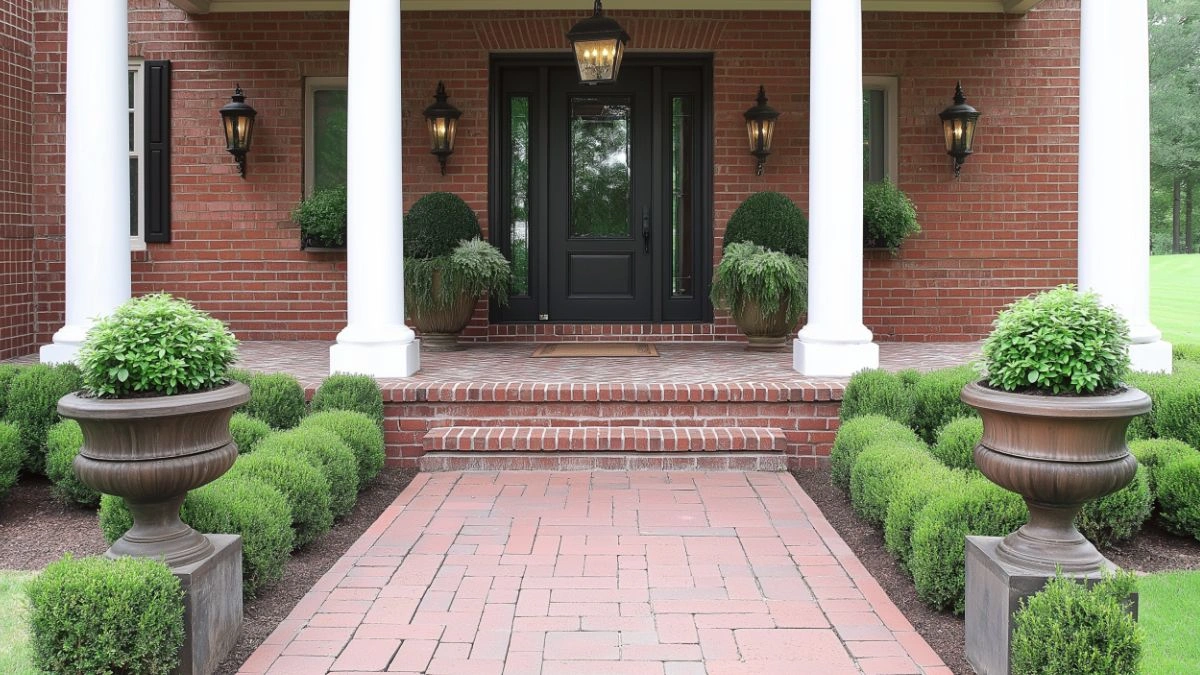Charming Front Porch Landscaping Concepts to Impress Your Guests
Table of Contents
Your front porch is more than a transitional space—it’s the welcome mat to your entire home. Whether you live in a cottage, townhouse, or farmhouse, the landscaping that frames your front porch is one of the first things guests notice. It sets the tone, establishes your home’s personality, and signals the care you take in your surroundings. A beautifully designed porch landscape doesn’t need to be extravagant—it just needs to feel intentional, inviting, and well-balanced.
According to home improvement experts, front yard landscaping can increase a home’s perceived value by up to 20%. That’s not just curb appeal—it’s character and warmth that greets your guests before you even open the door. From layered greenery and potted plants to stone borders, lighting, and seasonal touches, your front porch landscape should complement your home’s architecture while showcasing your personal style.
In this guide, we’ll walk through charming front porch landscaping concepts designed to impress. You’ll discover clever layout techniques, plant pairings, creative hardscape ideas, and low-maintenance tips to help transform your entrance into a visual treat. Whether you’re working with a wide veranda or a compact stoop, these design solutions offer timeless appeal with plenty of room for creativity.
Frame Your Porch with Symmetry and Structure
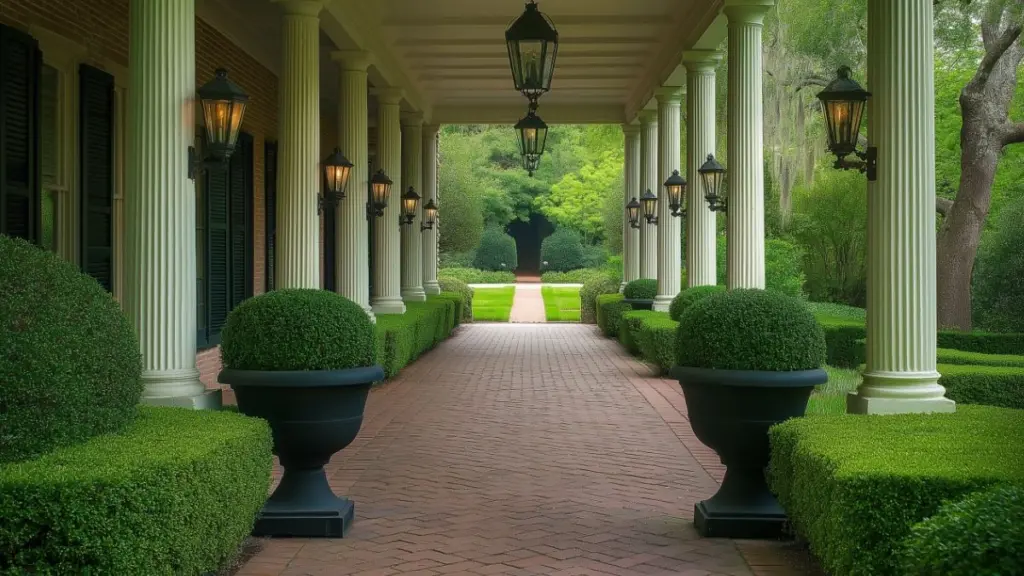
One of the most effective ways to enhance your porch landscaping is by using symmetrical arrangements and clearly defined structure. A balanced layout not only adds visual polish, but also gives your entrance a sense of formality and elegance.
Symmetrical Planters or Columns
Place matching planters on either side of your porch stairs or doorway. Use identical plant species or color palettes to anchor the entry and create harmony. Topiary spirals, boxwood spheres, or blooming urns work beautifully for this look.
Defined Pathways and Borders
Use clean edging materials—like brick, stone, or metal—to frame your walkway leading to the porch. This signals organization and intentionality while directing guest traffic.
Matching Lighting or Sconces
Flank your porch with matching wall lights or lanterns. These elevate evening curb appeal and reinforce symmetrical design language.
Table: Porch Framing Ideas for Symmetry
| Feature | Placement Location | Design Tip |
|---|---|---|
| Matching planters | Beside stairs or door | Choose evergreens for year-round appeal |
| Twin light fixtures | On either side of doorway | Keep finishes consistent with house exterior |
| Pathway borders | Along walkway edges | Use contrasting materials for visual pop |
| Trimmed hedges | Along porch perimeter | Keep height consistent for neat appearance |
Use Layered Planting for Depth and Color
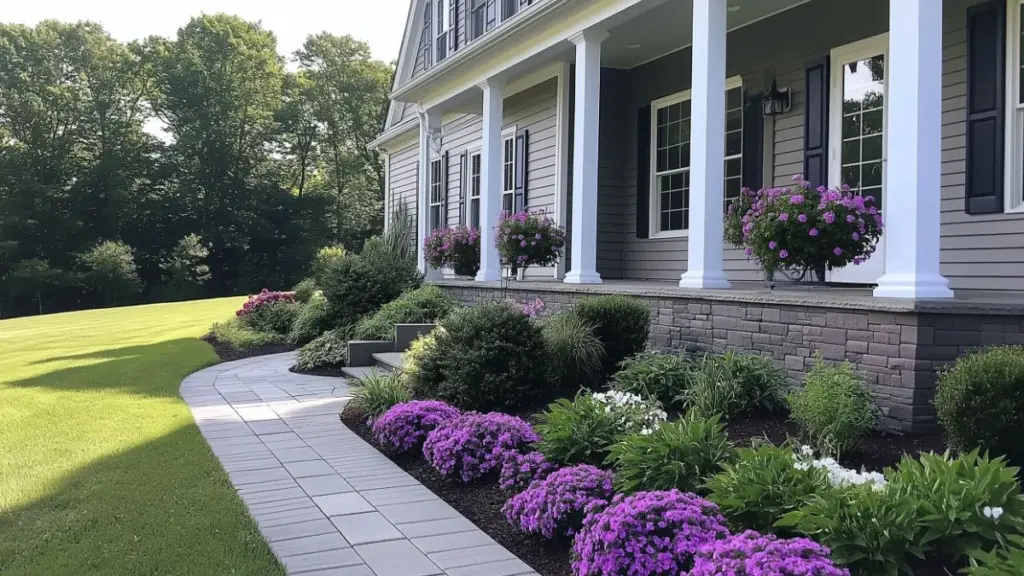
Layered landscaping is all about creating depth by combining plants of different heights, textures, and colors. This technique gives your porch a lush, garden-like feel that feels both natural and curated.
Start with Structural Greenery
Anchor the scene with shrubs or dwarf trees along the outer edges of your porch or steps. These could be boxwoods, arborvitae, or dwarf hydrangeas—plants that provide shape and substance.
Add Medium-Height Interest
Layer in flowering plants such as salvia, coreopsis, or coneflowers. These fill the mid-level space and introduce seasonal color. Vary bloom times for continued interest throughout the year.
Finish with Groundcovers or Creepers
Plant creeping thyme, sweet alyssum, or trailing lobelia near the base or in planter boxes. These soften borders and provide textural contrast.
Repeat the Pattern Strategically
For small porches, replicate the layered arrangement on both sides. For larger areas, stagger your groupings for a more relaxed effect.
Table: Layered Planting Plan
| Layer | Suggested Plants | Design Benefit |
|---|---|---|
| Tall backdrop | Boxwood, dwarf hydrangea | Defines the edge and adds privacy |
| Medium color pops | Coneflower, salvia, yarrow | Provides seasonal blooms and visual focus |
| Ground-level fill | Creeping thyme, sweet alyssum | Adds softness, scent, and visual flow |
Incorporate Hardscape Elements for Texture and Definition
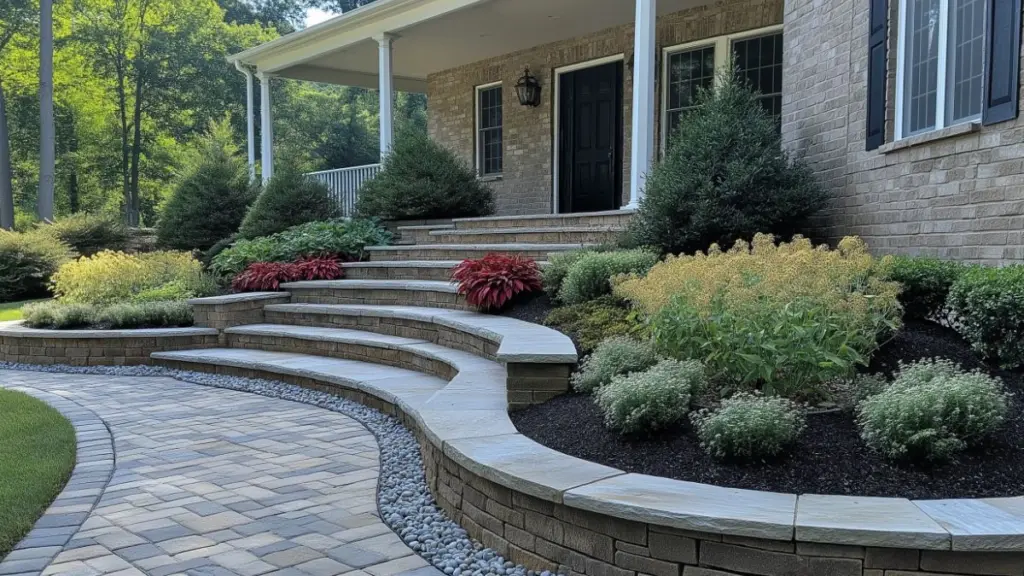
Hardscaping adds permanence, contrast, and texture to your landscaping design. Elements like stone walls, gravel paths, and paver borders elevate the porch without overwhelming it.
Stone or Brick Planter Beds
Build short retaining walls along the porch steps or in front of the porch skirting. These create raised beds ideal for seasonal planting and structural greenery.
Gravel Accents and Edging
Use pea gravel or decomposed granite to define spaces around planting areas. This adds a rustic touch and helps with drainage.
Flagstone or Paver Pathways
Upgrade your walkway with large pavers in natural tones. Irregular flagstones give a cottage feel, while clean-edged pavers look sleek and modern.
Table: Hardscape Ideas for Front Porches
| Element | Material Options | Ideal Use |
|---|---|---|
| Raised planter bed | Stone, brick, timber | Borders porch or steps |
| Ground cover edging | Gravel, river rock, mulch | Frames plants and aids drainage |
| Stepping stones | Concrete, slate, flagstone | Breaks up lawn space and leads to porch |
| Accent walls | Stacked stone or brick veneer | Adds height and structure near porch corners |
Add Vertical Interest with Trellises, Arbors, and Climbing Plants
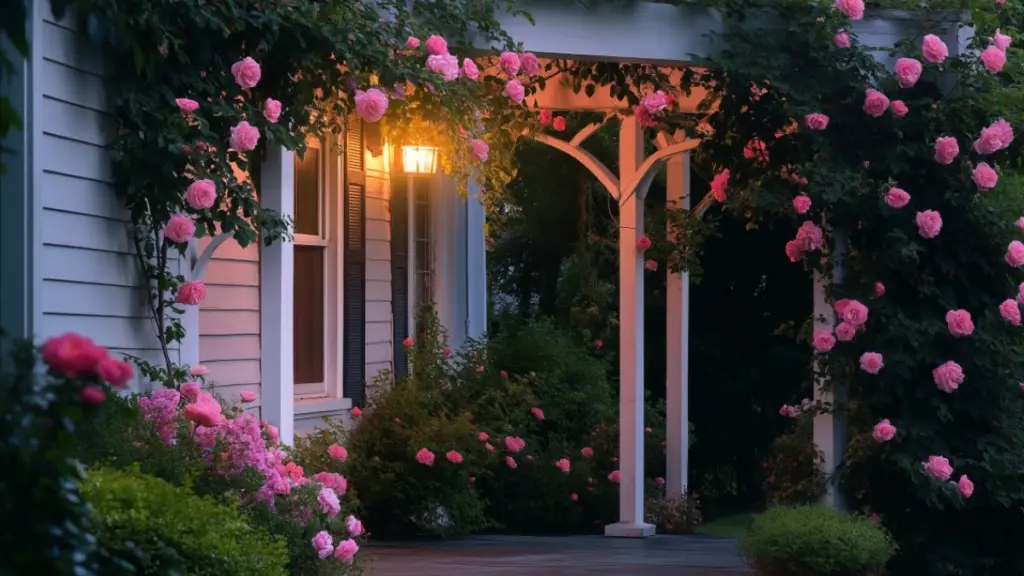
Not all porch landscaping needs to be at ground level. Adding vertical elements draws the eye upward and frames your home with organic elegance.
Install Trellises or Privacy Screens
Use decorative wooden trellises against porch railings or along side walls. These offer support for climbing plants and add architectural charm.
Grow Vines or Climbing Flowers
Clematis, honeysuckle, and climbing roses can be trained to grow upward, creating seasonal drama. Use containers or ground beds at the base for flexible setup.
Try an Entry Arbor
An arbor placed at the start of your walkway gives your home a storybook entrance. Frame it with climbing jasmine or grapevines for lush coverage.
Table: Vertical Porch Features
| Structure Type | Plant Pairing Suggestions | Design Effect |
|---|---|---|
| Porch trellis | Clematis, morning glory | Adds soft greenery against railings or walls |
| Entry arbor | Jasmine, wisteria | Creates a romantic welcome zone |
| Wall-mounted lattice | Climbing roses, ivy | Blends porch with garden elements |
| Pergola edge posts | Bougainvillea, grapevine | Shade and floral coverage over seating areas |
Create Seasonal Planter Displays for Year-Round Curb Appeal
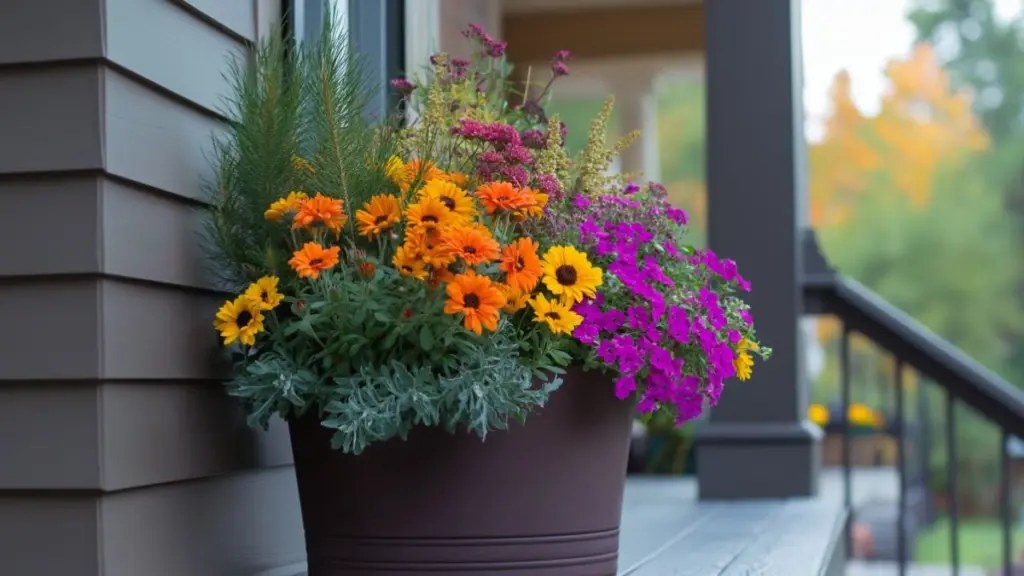
Planter displays are an easy way to add personality to your porch and adapt your landscaping with the seasons.
Spring and Summer Blooms
Opt for vibrant color combinations with tulips, daffodils, petunias, and begonias. Choose spillers and fillers to complement your thrillers for maximum visual impact.
Autumn Harvest Themes
Layer in ornamental cabbage, pansies, and dusty miller. Add pumpkins, hay bales, or lanterns for added seasonal ambiance.
Winter Greenery and Lights
Use fir branches, holly, pinecones, and winterberries. Incorporate string lights, metallic ornaments, or birch logs for holiday sparkle.
Table: Year-Round Planter Concepts
| Season | Suggested Plants and Decor | Container Tip |
|---|---|---|
| Spring | Daffodils, tulips, pansies + moss accents | Use pastel ceramic or white urns |
| Summer | Geraniums, sweet potato vine, ferns | Choose tall, colorful planters for impact |
| Fall | Mums, cabbage, gourds, corn stalks | Rustic barrels, galvanized tubs, or baskets |
| Winter | Evergreen clippings, pinecones, berries | Classic urns with natural or silver finish |
Blend Porch Landscaping with Your Home’s Architectural Style
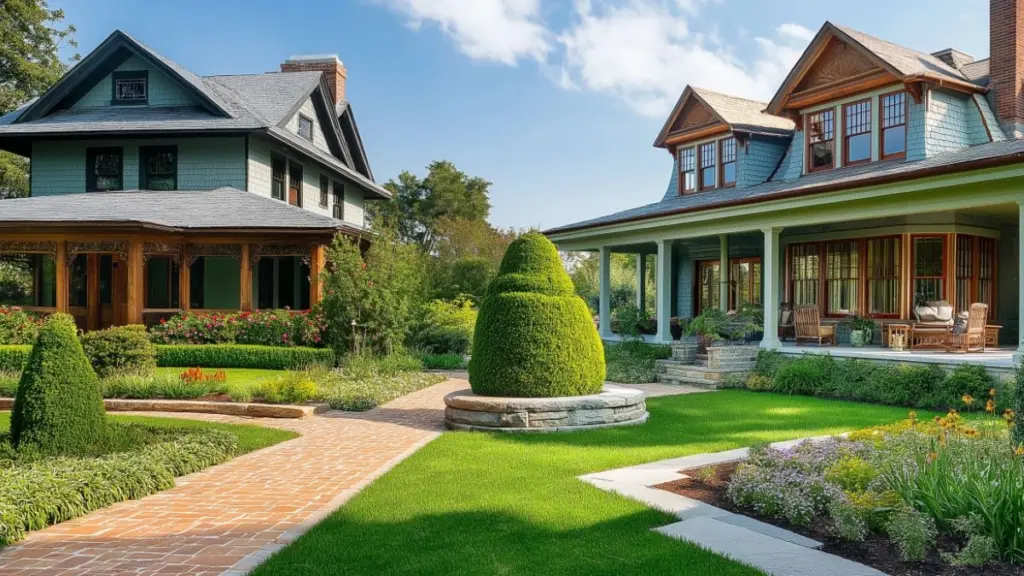
For a cohesive look, your front porch landscaping should feel like an extension of your home’s architectural identity. Whether your home is colonial, contemporary, or craftsman, the landscaping should echo its lines and personality.
Traditional or Colonial Homes
Symmetry, formal hedges, and neatly trimmed boxwoods complement classic facades. Use urns, lanterns, and brick accents to reinforce tradition.
Craftsman or Bungalow Homes
Natural materials like river stone, cedar mulch, and native plants highlight the handmade aesthetic. Layered greenery and cozy porches pair well with planters made from reclaimed wood.
Modern or Minimalist Designs
Clean lines, structured succulents, and monochromatic planters echo sleek architecture. Use symmetry and negative space for drama.
Cottage and Farmhouse Styles
Loose floral arrangements, climbing vines, and vintage containers like watering cans add character. Add white picket fencing or split-rail borders for country charm.
Table: Architectural Landscaping Pairings
| Home Style | Landscaping Elements | Key Accent Features |
|---|---|---|
| Colonial | Boxwoods, urns, brick edging | Symmetrical design, black lantern lights |
| Craftsman | Stone planters, native ferns | Warm wood finishes, layered beds |
| Modern | Succulents, black pots, grasses | Simple lines, concrete paths, steel lighting |
| Cottage/Farmhouse | Climbing roses, wicker planters | Rustic textures, asymmetrical garden beds |
Conclusion
Your front porch is the handshake of your home—an opportunity to create a warm, stylish, and lasting impression before anyone steps inside. With charming landscaping concepts that focus on structure, seasonality, color, and creativity, you can transform your porch into a visual invitation that speaks volumes about your care and personal taste.
From symmetrical plantings to climbing vines, curated hardscape features to mood-setting lights, it’s the layering of thoughtful details that elevates your curb appeal. No matter your budget or porch size, embracing these landscaping principles ensures your guests always feel welcome—and your home always looks its best.

